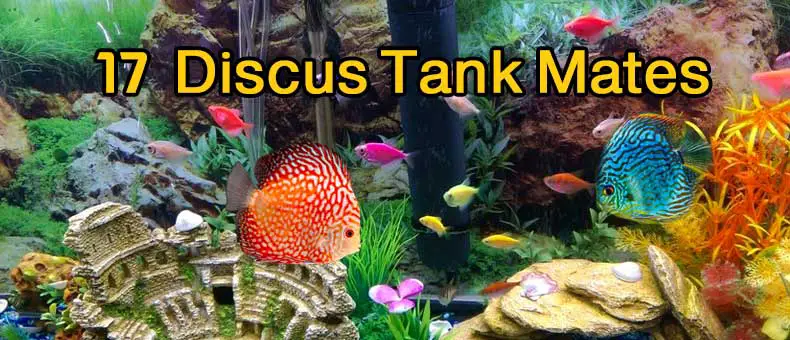
You can put some fishes that are compatible tank mates with Discus include but not limited to Cory fish, Assassin snail, Apisto Agassizi, Cardinal tetras, Plecos, Rainbowfish, Beckford’s Pencil fish, Penguin tetras, and German Blue ram among others.
Table of Contents
- 17 Best Discus Tank Mates
- [1] – Corydoras Sterbai
- [2] – Marbled Hatchetfish (Carnegiella Strigata)
- [3] – Rummynose Tetra (Hemigrammus Rhodostomus)
- [4] – Cardinal Tetra (Paracheirodon Axelrodi)
- [5] – Penguin Tetra
- [6] – Cardinal Tetra, Neon Tetra
- [7] – Glowlight Tetra
- [8] – Golden Rams
- [9] – Panda Cory
- [10] – Bleeding Heart Tetra
- [11] – Pleco (Small L-Numbers)
- [12] – Assassin Snail (Clea Helena)
- [13] – German Blue Ram (Mikrogeophagus Ramirezi)
- [14] – Beckford’s Pencilfish (Nannostomus Beckfordi)
- [15] – Twig Catfish (Sturisoma Panamense)
- [16] – Rainbow Fish
- [17] – Apisto Agassizi
- Related Questions
- 6 Discus Tank Mates To Avoid
- Conclusion
17 Best Discus Tank Mates
[1] – Corydoras Sterbai
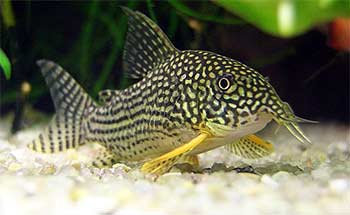
All the Corydoras species are very good fishes to be considered to be tank mates for Discus fishes as regards their temperament.
Among the most suitable tankmates for Discus fish is the Corydoras and the following are a couple of whys and wherefores. To start with, Corydoras species inhabit a totally separate layer of water; they mostly are substratal – to be specific, they like to stay around the bottom of the tank or aquarium, and they feed on the leftovers that your Discus might not have eaten.
They are commonly referred to as “armoured catfish” so it is unlikely for them to be provoked by Discus that could be making trouble.
If you are considering putting Cory catfish with your Discus, it is advised that you make sure that at least a school of about 6 of them be put together; this won’t be any trouble at all since aquariums for Discus tend to be large, and this is a good opportunity to observe the natural behaviour of the Cories.
For an even better environment, you should consider having leaf litter and driftwood in your aquarium so as to give your Discus and Cory catfishes the structure of an Amazon biotope which works well for both species.
[2] – Marbled Hatchetfish (Carnegiella Strigata)
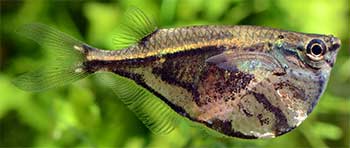
The hatchet fish is a very exquisite and absorbing species of fish, and they got their name from the uncommon way their bodies are shaped. Every kind of hatchet fish fits into the Discus fish tank mate compatibility bracket. However, the marbled hatchet fish, in particular, has its own uniqueness.
As is the case with the Cory catfish, the hatchet fish are very good tank mates for Discus because they prefer to reside in a separate layer of the tank-water and since they hardly ever leave the surface layer they occupy, there is hardly any reason for them to come in contact with Discus so there won’t be any fighting or nipping besides they are a peaceful kind of fish.
Hatchetfish prefer staying in an environment with vegetations that are hanging as well as a lot of places to hide and Discus on the other hand favour a lot of free space for swimming so how you design the aquarium must be tailored to suit the two species.
If you want the hatchet fish to feel secure, then you might consider procuring floating plants and get a school of about 10 of them that way, they know they are in the company of their kind.
One other thing to note about the hatchet fish is that they have acrobatic skills – they jump a lot and this they do most when they are startled. If your aquarium or tank does not have a lid or covering, it might be better you don’t keep them because although they are easy to keep, they are likely to jump out.
[3] – Rummynose Tetra (Hemigrammus Rhodostomus)
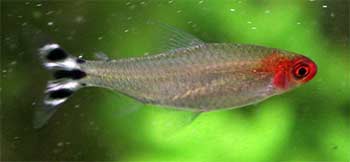
There are a lot of tetras that get a pass when talking about Discus fish tank mate compatibility, and one of them is the Rummynose tetra.
Among the fishes that prefer gathering or residing in the middle layer of water, the Rummynose tetras are the most popular and when they get to about 2 inches in size, they are big enough to not be considered as a meal or snack to Discus fishes.
More so, since they have a very peaceful disposition, it makes it easier and less stressful for them to cohabitate with Discus fishes.
It is very true that for Rummynose tetras, it is recommended that they are kept in water that has a little bit of low temperature than the warm water which Discus prefers, however fish breeders who have combined these two species have found that Rummynose tetras are able to cope with the warm water temperature.
The noses of Rummynose tetras are red in Colour, so if the noses become pale, it means that the quality of the tank water is bad.
As is the case with any other fish, it is better to have Rummynose tetras stay in groups; the recommended quantity is a school of 20 or more of the species. The ideal tank size is more than 20 gallons.
[4] – Cardinal Tetra (Paracheirodon Axelrodi)

Cardinal tetras are another kind of tetras that will fit well as tank mates for your Discus fish for one reason, they are aesthetic in appearance so they will pair well with the striking Colours of the Discus.
Cardinal tetras are alike with Neon tetras in that; they have the same Colours however, the Cardinal tetras are a bit larger in size.
Cardinal tetras are similar to Rummynose tetras in the sense that they have a calm and peaceful disposition and are very easy to breed. They have a glistening red, blue and silver pigmentation and as Discus fishes are larger than them, they are mostly found sticking together in their schools.
Cardinal tetras are a tizzy kind of fish – as a result, they tend to reduce or lower timorousness as well as aggression in their tank mates, this they do by encouraging a sense of tranquillity.
The ideal environment for Cardinal tetras is a tank size of over 20 gallons that is designed to mimic a South American biotope – blackwater and a little decoration with vegetation that is hanging, plants that float, leaf litter and driftwood – that favours both the Discus and Cardinal tetras.
[5] – Penguin Tetra
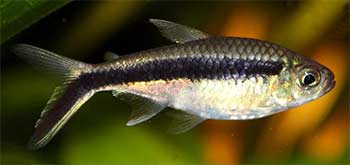
The Penguin tetra is a tetra species originating from the rivers and confluence of South America, and they make for good Discus fish tank mates.
Their Colours are pale gold, with a black stripe that goes down to the bottom of its tail such that the fish look like a penguin.
[6] – Cardinal Tetra, Neon Tetra
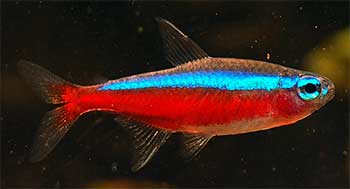
The outward and visible appearance of the Cardinal tetra, Neon tetra, is that it is long and the Colours on this species of tetra are very basic however one thing that is prominent is the two long strips that are adjacent to each other on the body of the fish – white above the black.
Although the name of this species is pretty usual, they don’t exactly look like the Neon tetras as those belonging to a different genus.
[7] – Glowlight Tetra
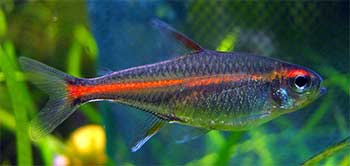
The Glowlight Tetra is another freshwater tetra species that originated in the streams of South America. They have bright neon red striations that run down their bodies from the nose to the tail. They are called Glowlight tetras because this bright neon red Colour gleams (glows) when the lights in the aquarium are dimmed.
They are very easy to keep, and they will do well in tank water that has a very good water condition, and the temperature does not go beyond 77º F.
The Glowlight tetras are small, and so there is more than enough room for their tank mates to do as they please; they are also not dithered when they eat, they do not shy away from eating any kind of fish food that is fed them. However, it is recommended that the food that is given to them are in small portions.
[8] – Golden Rams

Golden Ram Cichlids (Papiliochromis/Microgeophagus ramirezi) is a dwarf species of cichlids. They originate from the Orinoco River basin, in Llanos of Venezuela and Colombia in South America and reside in freshwater.
Like Discus fishes, they are shy and peaceful and favour soft and acidic tank water.
[9] – Panda Cory

Panda Cory catfish originate from the confluence of large rivers in both Central and South America.
They are a very peaceful species and like dwelling in the bottom part of the water where they can do their scavenging, their Colour is gold, and they have black patches that cover their eyes, dorsal fins, and the bottom area of their tails.
The aquarium should also contain sand or substrates of gravel, this is because their barbels can easily suffer harm or injury.
[10] – Bleeding Heart Tetra
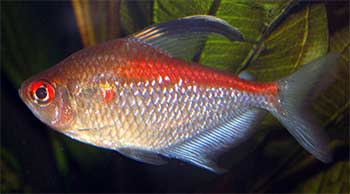
The Bleeding Heart Tetra is yet another species of tetra that originates from South America; it derived its name from the marks that are on its body. The fish has a blushing red Colour close to its gills that give it an appearance of a “bleeding heart”. It is a perfect tank mate for Discus fishes, and it does not need an expert breeder to keep.
Furthermore, if the tank water is a little bit acidic and is high infiltration, the Bleeding Heart tetra will thrive, and they feed on a lot of small portion fish foods like brine shrimp or daphnia, freeze-dried bloodworms and tubifex, micro pellet food, and high-quality flake foods.
[11] – Pleco (Small L-Numbers)

There is a major controversy as regards putting Pleco or L-number catfishes in a Discus fish aquarium. The reason for this is that there are certain Plecos that may consider the thick slime on the body of Discus fishes to be a meal, and as a result, they often attach themselves on the slow swimming Discus fishes and try to rip off the slime coat on their bodies. Thus, the Discus fishes are often left injured.
But the reality is that a lot of breeders have been able to combine Plecos with Discus fishes in an aquarium without having any nipping problems. The reason for this is that they go after the dwarf species of Plecos, not the bigger ones such as the Common Pleco or Sailfin Pleco.
Plecos that are ideal for Discus fish tank mate compatibility include Bristlenose Plecos, Zebra Plecos and Orange Spot Plecos since they remain small even past the age where a Common Pleco should have gotten bigger.
Eating leftover foods is not enough for Plecos to survive; it is recommended that they are fed some algae wafers as well to keep them happy and in wellness.
[12] – Assassin Snail (Clea Helena)
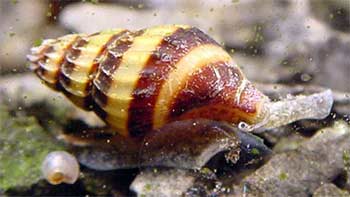
The Assassin snail is very good Discus fish tank mates because they are scavengers – they eat up any leftover foods that Discus fishes didn’t eat and thus reduce the risk of problems regarding water quality in the tank due to ammonia build-up resulting from the decay of leftovers.
It is important to bear in mind that Assassin snails bode well in harder and higher pH water than that which Discus fishes can survive in. If the hardness of the water is too low, the shells of the snail could deteriorate.
The Assassin snail is easy to keep, have a peaceful disposition and its ideal tank size is over 10 gallons.
[13] – German Blue Ram (Mikrogeophagus Ramirezi)

German Blue rams are known for their spectacular blue Colour, and they come from a family of cichlids like Discus fishes, they have a peaceful temperament which makes them compatible tank mates for Discus fishes.
If you are thinking about throwing in some German Blue rams into the aquarium with your Discus, ensure that you have provided a lot of cover at the bottom because German Blue rams are territorial, so it is best that your aquarium has flower pots or caves for them to have as a territory.
Blackwater, leaf litter and driftwood are favoured by both Discus and German Blue rams, also ensure that the tank water is in good condition.
[14] – Beckford’s Pencilfish (Nannostomus Beckfordi)
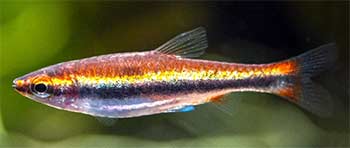
Another very good species of fish that you can combine in the same aquarium with Discus fishes is Beckford’s Pencilfish. The Rummynose and Cardinal tetras are very popular as Discus fish tank mates, but these species also hit the mark for Discus fish tank mate compatibility.
They have a calm and peaceful temperament, and they can grow large enough to not be considered as food by Discus fishes.
Like Discus fishes, Beckford’s Pencilfishes favour dark water aquarium that has driftwood in them as well as plants that float and have long roots.
They like being in large groups as it helps them stay calm and less jumpy.
[15] – Twig Catfish (Sturisoma Panamense)
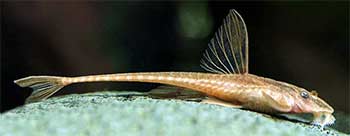
If you want to throw in catfishes into your Discus aquarium and you prefer a species that is more aesthetic in appearance than the Plecos, then you might like the stylish Royal Whiptail or Twig catfish which has an elongated body and large fins.
It is suitable as a Discus fish tank mate because it has a calm and peaceful disposition and there will hardly be any clash with Discus because these species prefer to latch onto surfaces in the aquarium such as driftwood.
As is the case with Plecos, it is advised that the Twig catfish be under close observation than some other suitable Discus fish tank mates.
Twig catfish don’t like a poor water condition which shouldn’t be difficult to manage since Discus fishes pretty much have the same preference.
[16] – Rainbow Fish
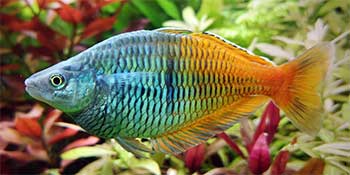
The Rainbowfish is an animated kind of fish; they are peaceful and cohabitate well with Discus fishes that are timid and not aggressive. They are little in size and appreciate a lot of free space for swimming; they also like to be in a large aquarium having lots of plants and substrates of gravel.
They share the same tank water requirements as Discus fishes with a temperature that is around 76º F and 82º F.
They are to be fed with a blend of vegetable matter and meat as well as flakes and pellets that are commercial-based.
[17] – Apisto Agassizi
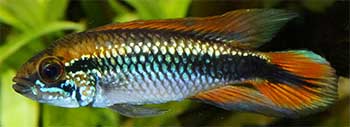
The Apisto Agassizi also originate from the Amazon basin like the Discus. They are also well-known aquarium fishes because they don’t cost much to breed and for their lively Colours.
They prefer warm tank water with a pH level of about 5 to 7, and the hardness of the water they appreciate is between 2 and 12 KH.
You can easily know when the environment in which you have placed this species is comfortable through the Colours on their body. Apisto Agassizi changes their Colour based on their mood; that way, you can know if they are happy, sad or under stress.
Related Questions
Is It Necessary To Add Discus Tank Mates?
No, it is not necessary for Discus fishes to have tank mates, However, there is an advantage to combining your Discus fishes with another species. Since Discus fishes are shy and skittish, fishes that are equally fussy such as a school of tetras can help Discus feel more secure.
How To Select Discus Tank Mates?
When selecting Discus tank mates, below are the things to bear in mind:
- Temperature.
- Water values.
- Temperament.
- Tank size.
- Biotope.
Temperature
When combining two species of fish, you have to examine if their ideal water temperatures are alike.
Since Discus prefer a warm temperature of tank water, fishes that prefer cooler temperatures won’t bode well in a Discus tank so it is best to look for fishes that either prefers warm temperatures or can adapt to them.
Water values
The waters in the Amazon river from which Discus originate are soft and acidic – a quality of water that must be replicated in your home aquarium. If the fish you intend to throw into the tank with the Discus favour hard water, they will not be suitable tank mates.
Temperament
Discus fishes are shy and have a peaceful disposition, and these are the exact qualities to look for when selecting tank mates for them. They will not get along with hyperactive, territorial or aggressive fishes.
Tank size
When introducing a new stock of fishes into your Discus tank, you must be sure that the tank is large enough to contain the number of fishes you want in the tank without any problems.
Overcrowding can stress Discus and a tank is overcrowded when it is not large enough to contain its inhabitants.
Biotope
It is important to design the aquarium to look like the natural habitat of the Discus and most breeders and aquarists make their tanks look dark like the waters of the Amazon and select tank mates that Discus could easily come across in their natural habitat.
6 Discus Tank Mates To Avoid
[1] – Flowerhorns

Flowerhorns are a result of different South African species that have been selectively bred. They have a distinctive head shape and elongated body. They have an aggressive disposition, fight with each other, and do not welcome foreign species.
Flowerhorns do like to swim in pairs (it is less stressful for them) even though they don’t favour being in large groups.
[2] – Piranhas

Piranhas are not exactly aggressive, having a lot of them in the tank promotes fussy behaviours. Since they don’t trust each other, they believe that too many of them together will lead to nipping. More so, even when they are well-fed, they still consider Discus to be food; thus, they are not ideal for Discus tank mates.
[3] – African Cichlids

These are territorial fishes and are very aggressive which makes them a bad matchup for Discus fishes. They are relatively large as well in comparison to Discus.
Fishes that should be kept with African cichlids must be large, aggressive enough to defend themselves, and swim fast.
[4] – Goldfish

Goldfish don’t favour the high-temperature tank water that Discus fishes prefer, although they can adapt and survive if they stay for a long period of time, it is still not their ideal habitat.
If you change the tank water daily, you will remove the debris and leftovers, so there is no point keeping a goldfish.
[5] – Oscars

Oscar fishes originate from tropical South America and are members of the family of cichlids. They are freshwater fishes and display scintillating exquisiteness and grace when they swim.
They are however aggressive which makes removes them as options for Discus fish tank mates.
[6] – Angelfish
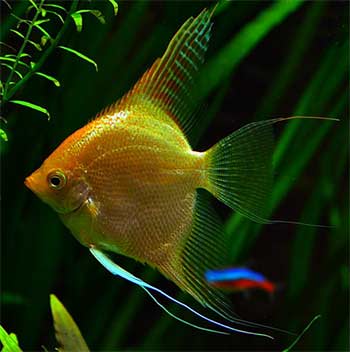
Angelfish originated from an area of tropical South America and some areas of the Amazon river. Although they are peaceful in general, they can be pretty aggressive to each other sometimes and will not back away from eating smaller fishes which makes them a bad matchup for Discus.
Angelfish and Discus are both cichlids and cichlids have a problem cohabiting with other cichlids and other fish species as they are territorial and aggressive by nature. However, Discus is neither territorial nor aggressive.
Conclusion
If you want your Discus to have tank mates, ensure to look out for fishes that can adapt to the water condition, share similar water temperatures, have a peaceful disposition, and are not small enough to be considered as food by Discus fishes.


Thanks my discus fish tank has other fishies like some fish like a baby discus that the shape have a little wider, a tank cleaning fish.